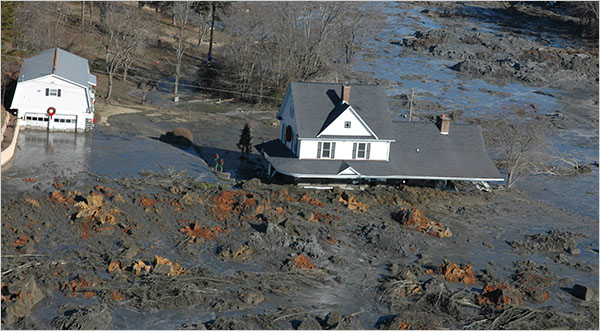Sludgecore
 [Image: Sludge makes itself at home in Harrimann, Tennessee; photo by J. Miles Carey/Knoxville News Sentinel, via Associated Press/New York Times].
[Image: Sludge makes itself at home in Harrimann, Tennessee; photo by J. Miles Carey/Knoxville News Sentinel, via Associated Press/New York Times].Earlier this week the retaining wall of a massive sludge dam gave way 40 miles west of Knoxville, Tennessee, resulting in a coal ash spill that now lies "thick and largely untouched over hundreds of acres of land and waterways."
Houses and business have been buried whole or swept off their foundations by the potentially toxic material; amidst its unnaturally concentrated ingredients are selenium, arsenic, and lead, all of which produce "neurological problems" and cancer.
"The breach occurred," the New York Times explains, as if describing a painting by from a little-known Appalachian Series by Caspar David Friedrich, "when an earthen dike, the only thing separating millions of cubic yards of ash from the river, gave way, releasing a glossy sea of muck, four to six feet thick, dotted with icebergs of ash across the landscape. Where the Clinch River joined the Tennessee, a clear demarcation was visible between the soiled waters of the former and the clear brown broth of the latter."
An updated aerial survey now suggests that more than 5 million cubic yards of this possibly neurologically-active waste has been released – "enough to flood more than 3,000 acres one foot deep" – forming a new self-organized landscape of industrial byproducts, a future stratigraphic surprise for our next millennium's archaeologists.
Or perhaps this is the metallization of the world long ago dreamed of by the Italian futurists. Adventures in metallized deterrestrialization.





Comments are moderated.
If it's not spam, it will appear here shortly!
I hope this terrible incident provides the same stop on coal that Three Mile Island and Chernobyl provided for nuclear (the relatvely undramatic spewing of mercury, particulates and CO2 still seems to go unnoticed).
Question: fly ash is used in some concrete mixtures and as such is marketed as a "green" additive. Are these heavy metals somehow removed before the fly ash is mixed with the concrete? Could this so called "green" concrete actually be toxic from the addition of fly ash?
To become victim to poisoning from fly ash you'd actually have to ingest it in some way, not really an easy task unless you eat concrete on occasion. I think using fly ash as an additive and calling it "green" is that it substitutes a lot of the cement that is usually required in concrete. Think of it as "green" in the sense that rather than having to create cement to add to the concrete, they are rather finding a use for a material otherwise thought of as solely a waste material.
The analogy coming to my mind is Love Canal: unless they can clean up the sludge AND the contaminants it leaves behind, that area probably won't be too safe to live in.
Post a Comment